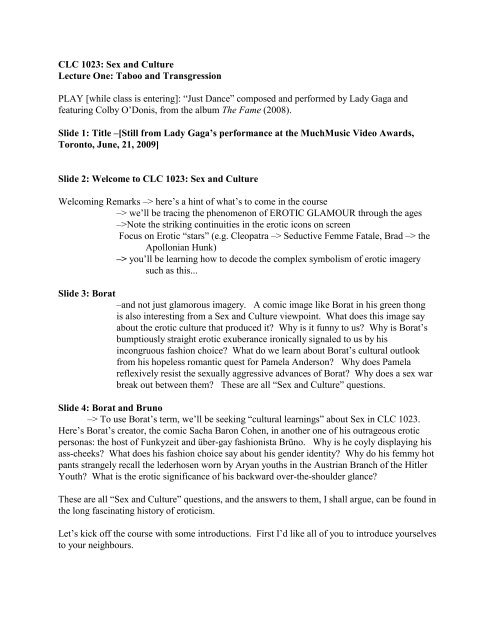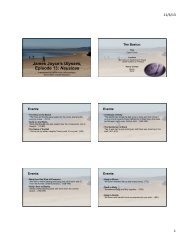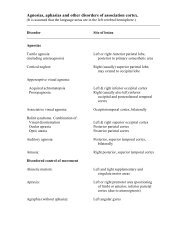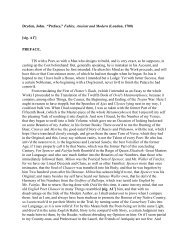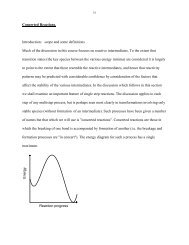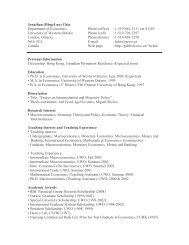CLC 1023: Sex and Culture Lecture One: Taboo and Transgression ...
CLC 1023: Sex and Culture Lecture One: Taboo and Transgression ...
CLC 1023: Sex and Culture Lecture One: Taboo and Transgression ...
Create successful ePaper yourself
Turn your PDF publications into a flip-book with our unique Google optimized e-Paper software.
<strong>CLC</strong> <strong>1023</strong>: <strong>Sex</strong> <strong>and</strong> <strong>Culture</strong><br />
<strong>Lecture</strong> <strong>One</strong>: <strong>Taboo</strong> <strong>and</strong> <strong>Transgression</strong><br />
PLAY [while class is entering]: “Just Dance” composed <strong>and</strong> performed by Lady Gaga <strong>and</strong><br />
featuring Colby O’Donis, from the album The Fame (2008).<br />
Slide 1: Title –[Still from Lady Gaga’s performance at the MuchMusic Video Awards,<br />
Toronto, June, 21, 2009]<br />
Slide 2: Welcome to <strong>CLC</strong> <strong>1023</strong>: <strong>Sex</strong> <strong>and</strong> <strong>Culture</strong><br />
Welcoming Remarks –> here’s a hint of what’s to come in the course<br />
–> we’ll be tracing the phenomenon of EROTIC GLAMOUR through the ages<br />
–>Note the striking continuities in the erotic icons on screen<br />
Focus on Erotic “stars” (e.g. Cleopatra –> Seductive Femme Fatale, Brad –> the<br />
Apollonian Hunk)<br />
–> you’ll be learning how to decode the complex symbolism of erotic imagery<br />
such as this...<br />
Slide 3: Borat<br />
–<strong>and</strong> not just glamorous imagery. A comic image like Borat in his green thong<br />
is also interesting from a <strong>Sex</strong> <strong>and</strong> <strong>Culture</strong> viewpoint. What does this image say<br />
about the erotic culture that produced it? Why is it funny to us? Why is Borat’s<br />
bumptiously straight erotic exuberance ironically signaled to us by his<br />
incongruous fashion choice? What do we learn about Borat’s cultural outlook<br />
from his hopeless romantic quest for Pamela Anderson? Why does Pamela<br />
reflexively resist the sexually aggressive advances of Borat? Why does a sex war<br />
break out between them? These are all “<strong>Sex</strong> <strong>and</strong> <strong>Culture</strong>” questions.<br />
Slide 4: Borat <strong>and</strong> Bruno<br />
–> To use Borat’s term, we’ll be seeking “cultural learnings” about <strong>Sex</strong> in <strong>CLC</strong> <strong>1023</strong>.<br />
Here’s Borat’s creator, the comic Sacha Baron Cohen, in another one of his outrageous erotic<br />
personas: the host of Funkyzeit <strong>and</strong> über-gay fashionista Brüno. Why is he coyly displaying his<br />
ass-cheeks? What does his fashion choice say about his gender identity? Why do his femmy hot<br />
pants strangely recall the lederhosen worn by Aryan youths in the Austrian Branch of the Hitler<br />
Youth? What is the erotic significance of his backward over-the-shoulder glance?<br />
These are all “<strong>Sex</strong> <strong>and</strong> <strong>Culture</strong>” questions, <strong>and</strong> the answers to them, I shall argue, can be found in<br />
the long fascinating history of eroticism.<br />
Let’s kick off the course with some introductions. First I’d like all of you to introduce yourselves<br />
to your neighbours.
Slide 5: Professor James Miller<br />
Now let me introduce myself...<br />
Course Director<br />
Professor James Miller<br />
Slide 6: Book Cover –> Dante & the Unorthodox<br />
A good way to get to know your profs is by reading their books. Here’s the cover of my most<br />
recent book – Dante & the Unorthodox – a study of Italy’s most famous (<strong>and</strong> in my view most<br />
transgressively erotic) poet, Dante Alighieri, whose great poem the Inferno we’ll be reading<br />
together at the end of the first term.<br />
Slide 7: Professor Miller’s Office in the Pride Library<br />
My office is located in the Pride Library on the mainfloor of Weldon.<br />
My office hours are Thursdays, 9-11am.<br />
Slide 8: Professor Kelly Olson<br />
Adjunct Co-Ordinator / Principal Guest <strong>Lecture</strong>r<br />
Professor Kelly Olson<br />
Professor Olson’s office is in the Department of Classical Studies,<br />
Talbot College, room 425<br />
Slide 9: Book Cover –> Dress <strong>and</strong> the Roman Woman<br />
And here’s Professor Olson’s fabulous new book....there’s a copy of it in the Pride<br />
Library. Check it out!<br />
INVITE Professor Olson to say a few words.<br />
Slide 10: The TA Team –> “The Fantastic Five”<br />
Teaching Assistants for 2009-2010<br />
Bruna Reis breis @ uwo.ca<br />
Lydia (Tingfang) Du dtingfan @ uwo.ca<br />
Mansoor Behnam mbehnam @ uwo.ca<br />
Rahel Nega rnega @ uwo.ca<br />
Echo (Yanxiang) Wu ywu332 @ uwo.ca
Slide 11: Breakout Groups<br />
The TA Team will be in charge of the Breakout Groups. So let me explain what’s meant by a<br />
“Breakout Group”.<br />
The class as a whole will meet for lectures on ALL Mondays <strong>and</strong> Wednesdays <strong>and</strong> on MOST<br />
Fridays during both terms. However, six times each term, always on a Friday afternoon between<br />
3:30 <strong>and</strong> 4:20, the general assembly of <strong>CLC</strong> <strong>1023</strong> students will divide into five smaller groups of<br />
approximately 40 students per group.<br />
Breakout Group meetings will be held in separate rooms away from our usual location for<br />
lectures in Middlesex College 110. Room allocations will be announced in lecture well in<br />
advance of the first meeting <strong>and</strong> will be posted on the course website.<br />
Your group-leader will be one of the teaching assistants in <strong>CLC</strong> <strong>1023</strong>. Your TA will lead<br />
discussions during the meetings of your group <strong>and</strong> will grade all of your assignments for the<br />
course. So make a point of getting to know your TA.<br />
Strictly speaking, these Breakout Groups are not "tutorials" because they do not meet each week<br />
at diverse times. Like tutorials, however, they will offer students an opportunity to discuss the<br />
readings <strong>and</strong> topics of the course in a less intimidating milieu than the big lecture hall where the<br />
class normally meets. The required readings <strong>and</strong> discussion topics for each session of the<br />
Breakout Groups are listed in the <strong>CLC</strong> <strong>1023</strong> overview <strong>and</strong> syllabus.<br />
Slide 12: Questions about Breakout Groups<br />
You probably still have lots of questions about breakout groups: e.g. Who is my TA? Which<br />
group am I in? Where will my group meet?<br />
Here’s my immediate answer to these questions:<br />
Slide 13: Stay Tuned –> All will be revealed in due course.<br />
After the add-drop period in September, you will be assigned to one of these groups. So stay<br />
tuned – I’ll be dividing you up into your groups later this month.<br />
(Unfortunately, there’s no Sorting Hat as in Harry Potter!).<br />
Starting in October, the breakout groups will meet (usually) every other Friday: The first meeting<br />
will be on Friday October 2 –> at the end of week four.<br />
Schedule of Breakout Groups through the Year<br />
First Term Second Term<br />
Friday, October 2<br />
Friday, October 9<br />
Friday, January 22<br />
Friday, February 5<br />
Friday, October 23 Friday, February 26
Friday, November 6 Friday, March 5<br />
Friday November 20 Friday, March 19<br />
Friday, December 4 Friday, April 2<br />
Now some advice on preparing yourself for the course.<br />
Slide 14: Read the Course Guidebook this weekend.<br />
Your only reading assignment for this weekend will be to read the Course Guidebook. Please<br />
check it out ALL THE WAY THROUGH: you’ll find the schedule of lectures <strong>and</strong> readings, ,<br />
aims of the course, <strong>and</strong> even tips on how to read for the exams.<br />
Slide 15: Don’t Get Burned!<br />
Check out ALL the course policies in the Guidebook:<br />
e.g. submission policy, assignment deadlines, instructions for each assignment,<br />
proper formating of assignments, etc.<br />
Slide 16: Grade Breakdown<br />
Here’s an example of the useful information you’ll find in the Course Guidebook:<br />
The grade breakdown for this course is easy to remember. Everything gradable is worth<br />
ten marks each, <strong>and</strong> there are ten things that you’ll be graded on:<br />
Group Attendance 10<br />
nd<br />
2 term Engagement 10<br />
Assignment #1 10<br />
Assignment #2 10<br />
Assignment #3 10<br />
Assignment #4 10<br />
Midterm Test 10<br />
Final Exam: Part #1 10<br />
Final Exam: Part #2 10<br />
Final Exam: Part #3 10<br />
100<br />
If you lose your guidebook, you can download a copy from WebCT (more about WebCT<br />
that next week).<br />
* * *<br />
Now, for the rest of today’s class, I’d like to demonstrate for you the typical way a lecture will be<br />
organized in <strong>CLC</strong> <strong>1023</strong>.
Slide 17: Theme Song –> Image of Lady Gaga<br />
Just before each lecture, as you’re coming into hall <strong>and</strong> taking your seat, I’ll play a pop song<br />
relevant to the theme of the day’s lecture.<br />
ASK CLASS: Anyone recall today’s theme song?<br />
Lady Gaga’s recent hit “Just Dance”<br />
Slide 18: Repeat of title slide<br />
The first thing I want you to notice in the presentation of my lectures is a powerpoint slide with<br />
the number <strong>and</strong> title of the day’s lecture. The title will spell out the main topics under discussion.<br />
There’ll always be an image appropriate for the theme of the lecture. Here’s a suggestive still<br />
from Lady Gaga’s extraordinary performance at the Much Music Video Awards on June 21,<br />
2009. When you’re waiting for lecture to begin, you’re invited to meditate on the relation<br />
between the image on my title slide <strong>and</strong> the theme of the day’s lecture, in this case “<strong>Taboo</strong> <strong>and</strong><br />
<strong>Transgression</strong>” (more about these keyterms a bit later...)<br />
Slide 19: Closeup of Lady Gaga’s exploding breastpiece<br />
ASK CLASS: How can we tell that this is an erotic picture? What clues us into the sexual<br />
significance of this performance?<br />
Slide 20: Excerpt of Lyrics from “Just Dance”<br />
I've had a little bit too much<br />
(Much)<br />
All of the people start to rush<br />
(Start to rush by)<br />
A dizzy twister dance---------------------------------> momentum like a tornado. Implications?<br />
Can't find my drink or man<br />
Where are my keys? I lost my phone<br />
Slide 21: Lyrics cont’d<br />
What's go-in' on on the floor?---------------------> a good sex <strong>and</strong> culture question: search for<br />
I love this record baby meaning through close observation of erotic<br />
But I can't see straight anymore signs <strong>and</strong> signals, gestures <strong>and</strong> acts<br />
Keep it cool, what's the name of this club?<br />
I can't remember but it's alright, a-alright
Slide 22: Lyrics cont’d<br />
Wish I could shut my playboy mouth<br />
How'd I turn my shirt inside out?<br />
(Inside out right)<br />
Control your poison babe<br />
Roses have thorns, they say---------------------> dancefloor morphs into a garden. Women<br />
And we're all gettin' hosed tonight as roses to be “plucked” –> ancient image of<br />
What? Deflowering virgins?<br />
Slide 23: Lyrics cont’d<br />
additional words adding to the feeling of giddy disorientation in the dance:<br />
rush, lost, can’t see straight, can’t remember, inside out, poison, hosed<br />
It’s in this state of sexual doubt, bewilderment, disorientation that the lost “I” seeks cultural<br />
wisdom about the erotic life<br />
_____________________________________________________________________________<br />
[Here is a transcript of the rest of the lyrics for anyone who wants to puzzle over their<br />
significance in a sex <strong>and</strong> culture context:<br />
What's go-in' on on the floor?<br />
I love this record baby<br />
But I can't see straight anymore<br />
Keep it cool, what's the name of this club?<br />
I can't remember but it's alright, a-alright<br />
[CHORUS]<br />
Just dance, Gonna be okay<br />
Da-da-doo-doot-n<br />
Just dance, Spin that record babe<br />
Da-da-doo-doot-n<br />
Just dance, Gonna be okay<br />
D-d-d-dance, dance, dance<br />
J-j-just dance.<br />
When I come through on the dance floor checkin' out that catalogue (Hey!)<br />
Can't believe my eyes so many women without a flaw (Hey!)
And I ain't gonna give it up, steady tryna' pick it up like a call (Hey!)<br />
I’m a hit it up beat it up latch on to it until tomorrow yeah<br />
Shorty I can see that you got so much energy<br />
The way you twirlin’ up them hips round <strong>and</strong> round<br />
There's no reason at all why you can't leave here with me<br />
In the meantime st<strong>and</strong>, let me watch you break it down <strong>and</strong>...<br />
[CHORUS]<br />
Just dance, Gonna be okay<br />
Da-da-doo-doot-n<br />
Just dance, Spin that record babe<br />
Da-da-doo-doot-n<br />
Just dance, Gonna be okay<br />
D-d-d-dance, dance, dance<br />
J-j-just dance<br />
Half psychotic sick hypnotic<br />
Got my blueprint it's symphonic<br />
Half psychotic sick hypnotic<br />
Got my blueprint electronic<br />
[x2]<br />
Go! Use your muscle, carve it out, work it, hustle!<br />
(I got it, just stay close enough to get it)<br />
Don't slow! Drive it, Clean it lysol<br />
Bleed it, Spend the last dough<br />
(I got it)<br />
In your pock-o<br />
(I got it)<br />
Just dance, Gonna be okay<br />
Da-doo-doo-doot-n<br />
Just dance, Spin that record babe<br />
Da-doo-doo-doot-n<br />
Just dance, Baby! (Gonna be okay)<br />
Da-doo-doo-doot-n<br />
Just Dance, Spin that record babe<br />
Baby! Yeah... (Da-doo-doo-doot-n)<br />
Just Dance, Gonna be okay<br />
Spin that record baby! Yeah!<br />
(Dance, dance, dance)<br />
J-j-j-just dance<br />
______________________________________________________________________________
Slide 24: <strong>Sex</strong> as a Dance<br />
Lady Gaga’s lyrics evoke an ancient representation of sex as an experience springing from <strong>and</strong><br />
comparable to a dance. We’ll be studying the erotic allegory of the dance in its many cultural<br />
variations throughout the course.<br />
What sort of erotic dance does Lady Gaga evoke in her lyrics?<br />
Slide 25: Dance of Maenads<br />
The tipsy, disorientated movements of the singer hark back to the wild steps of the bacchic<br />
dancers of ancient Greece – the Maenads. The Maenads experienced a manic enthusiasm for<br />
their divine leader, the wine-god Dionysus. They were maddened by his intoxicating presence<br />
<strong>and</strong> couldn’t control themselves when they were possessed by him. Lady Gaga seems to let her<br />
inner Maenad out when she utters her mad chant towards the end of “Just Dance”<br />
Half psychotic sick hypnotic<br />
Got my blueprint it's symphonic<br />
No matter how often she assures herself that she’s “gonna be OK” by just dancing, her crazy<br />
jabbering towards the end of “Just Dance” suggests that she’s headed for trouble.<br />
We’ll be encountering their version of the erotic dance when we read Euripides’s tragedy The<br />
Bacchae in a few weeks.<br />
Slide 26: Dance of Amorous Lords <strong>and</strong> Ladies<br />
Lady Gaga’s proverbial utterance “Roses have thorns they say” resonates with the allegory of the<br />
erotic dance in the medieval French poem The Romance of the Rose, which starts out with a<br />
bewildered young lover entering a garden where a lord named Delight leads a fashionable caroldance<br />
of knights <strong>and</strong> ladies. The naive lover is invited into the dance by Courtesy, but is soon<br />
whirled around by the social movement until he falls head over heels in love with an aristocratic<br />
maiden symbolized by a rosebud. Stay tuned for what happens in the Garden of the Rose.<br />
Slide 27: Dance of <strong>Sex</strong>ual Damned<br />
Here’s another erotic movement that Lady Gaga’s lyrics evoke for me. Her “dizzy twisting<br />
dance” looks back to the whirlwind of the <strong>Sex</strong>ual Damned in the fifth canto of Dante’s Inferno,<br />
which we’ll be reading near the end of first term. This is the English poet William Blake’s<br />
dynamic illustration of Dante’s vision of the erotic dance as a tornado. Hold on to your hats.
Slide 28: Dance of Playboy Centrefolds<br />
When Lady Gaga sings “wish I could shut my playboy mouth,” she is of course directly alluding<br />
to a contemporary version of the Dance of <strong>Sex</strong>ual Desire: the disco rush of glamorous sex<br />
symbols on the covers of Playboy <strong>and</strong> other so-called “adult” magazines – like Carmen Electra<br />
here “baring her Fender.” The pouting open mouths on such figures mimic the invitations to a<br />
kiss in the iconic portraits of Marilyn Monroe <strong>and</strong> other Hollywood Screen Idols. More about<br />
that when we come to Hollywood in the second term.<br />
What all these variations of the erotic dance provide us with are ways of underst<strong>and</strong>ing the<br />
complexity of sexual experience – they are ritual signs of the erotic life that <strong>Culture</strong> repeatedly<br />
invents <strong>and</strong> reinvents to help us decode the mysteries of sex, to define its ever elusive meanings.<br />
Can there be <strong>Sex</strong> (in any meaningful sense) without <strong>Culture</strong>?<br />
Slide 29: <strong>Sex</strong> without <strong>Culture</strong>/ <strong>Sex</strong>ual <strong>Culture</strong> –> THOUGHT EXPERIMENT<br />
As a thought experiment, I’d like you to try to imagine sex without culture <strong>and</strong> then to contrast<br />
what you imagine sex without culture might be with your present (extensive?) knowledge of<br />
sexual culture.<br />
Slide 30:Development of the contrast<br />
I’d venture to suggest that <strong>Sex</strong> without <strong>Culture</strong> (if it ever existed) is now for us<br />
virtually UNKNOWABLE.<br />
<strong>Sex</strong> without <strong>Culture</strong> is still imaginable perhaps – like the State of Nature – but our collective<br />
fantasies of it would probably generate a set of adjectives such as these:<br />
<strong>Sex</strong> without <strong>Culture</strong> <strong>Sex</strong>ual <strong>Culture</strong><br />
Hard to know<br />
Mysterious<br />
Unruly<br />
Frightening<br />
Overwhelming<br />
Now let’s fill in the other column. It’s much easier to do!
Slide 31: Development of the contrast cont’d<br />
<strong>Sex</strong> without <strong>Culture</strong> <strong>Sex</strong>ual <strong>Culture</strong><br />
Hard to know Intelligibly coded<br />
Mysterious Manifest (exposed)<br />
Unruly Regulated<br />
Frightening Encouraging, even consoling<br />
Overwhelming Controlled<br />
Slide 32: What sexual culture provides us with...<br />
CULTURE constantly provides us with “vehicles” to carry our thoughts about SEX from the<br />
unknown to the known. By “vehicles” I don’t literally mean CARS – though cars <strong>and</strong> other<br />
mechanical things can certainly function as signs in erotic allegories. By erotic “vehicle” I mean<br />
a figurative image that carries with it – or conveys our thoughts to – a certain decodable<br />
underst<strong>and</strong>ing of the erotic life. Lady Gaga’s pectoral fireworks, for instance, certainly function<br />
as signs of a certain cultural perception of erotic desire as a fiery explosion..<br />
Slide 33: Overarching Theme for <strong>CLC</strong> <strong>1023</strong> – <strong>Sex</strong> <strong>and</strong> the Cities<br />
The overarching theme for the course is accordingly very urban – “<strong>Sex</strong> <strong>and</strong> the Cities”<br />
a theme reflected in the organization of the course as an imaginary tour of the great erotic capitals<br />
of the world starting with the ancient city of Babylon.<br />
Slide 34: Advertisement for the Television Series “<strong>Sex</strong> <strong>and</strong> the City”<br />
The idea for the course was suggested to me by the popular television series “<strong>Sex</strong> <strong>and</strong> the City,”<br />
which locates the erotic capital of the world in Manhattan.<br />
What does this advertisement for the television series suggest about the relation between sex <strong>and</strong><br />
the city?<br />
By organizing the course around this theme of <strong>Sex</strong> <strong>and</strong> the Cities, I don’t mean to imply (of<br />
course) that cities are the only place where sex occurs these days, or where sexual acts occurred<br />
in the past.<br />
Consider, for instance, this remarkable object.
Slide 35: Mystery Object<br />
Can anyone suggest what it might be?<br />
Slide 36: Close-up of the Stone “Tool” (Hohle Fels Object)<br />
Date: approximately 28,000 years old<br />
Discovered in the Hohle Fels Cave near Ulm in the Swabian Jura (Southern Germany)<br />
This stone object (20cm long, 3cm wide) has provoked a great deal of discussion among<br />
archeologists <strong>and</strong> anthropologists. It’s pretty obvious that it’s a sculptural representation of a<br />
prehistoric penis, but what was its use? If it was not a sacred object in some kind of phallic cult<br />
-- a fertility charm perhaps? -- it might have functioned as a “tool” in a practical sense. Scratches<br />
on its surface suggest that it may have been used to chip away at flintstones. Was it a male<br />
“tool” to make men’s tools?<br />
Or was it a sex toy from the Ice Age? Is so, then it may well be the oldest DILDO on record.<br />
Who would have used it? Cave-women? Or (Gay) Cave-men?<br />
We can be pretty sure that whoever used it was doing a great deal more than sleeping in the<br />
Hohle Fels Cave!<br />
By organizing the course as an imaginary tour of erotic cities, I don’t mean to imply that sex as a<br />
human action was invented by city-people. However, I do mean to imply that our underst<strong>and</strong>ing<br />
of the history of sex as a culturally regulated activity is very dependent on something that was<br />
invented by city-people a very long time ago –> an invention like WRITING –> THE<br />
CREATION OF TEXTS.<br />
Slide 37: Ancient Texts from Babylon<br />
Here are two examples of ancient writing: cuneiform tablets of excerpts from the great erotic epic<br />
Gilgamesh from ancient city of Babylon.<br />
Now think back to that advertisement for “<strong>Sex</strong> <strong>and</strong> the City”: What was Carrie Bradshaw holding<br />
in her lap as if it was an extension of her genital area?
Slide 38: <strong>Sex</strong>uality / Textuality<br />
Answer: A “Laptop” –> a technological symbol of her participation in the conjoining systems of<br />
sexuality <strong>and</strong> textuality<br />
Important Point:<br />
SEXUALITY (as a system of erotic signs, controls, meanings) is deeply connected with<br />
TEXTUALITY (as a system of symbolic inscriptions <strong>and</strong> archival records)<br />
Slide 39: Tom of Finl<strong>and</strong> clones reading<br />
Here’s a gay version of the symbolic connection between sexuality <strong>and</strong> textuality.<br />
[note visual pun: the “bum” of the book, where the pages meet in the centre]<br />
Slide 40: Conceptual Foundations<br />
In the three lectures next week we’ll be starting the course by laying down some conceptual<br />
foundations related to the basic connection between sexuality <strong>and</strong> textuality.<br />
Slide 41: <strong>Taboo</strong> <strong>and</strong> <strong>Transgression</strong><br />
The foundational concepts I’d like to start us off with today are drawn from social anthropology,<br />
<strong>and</strong> I’ll be using them frequently all year through the course. So before I begin to apply them to<br />
the interpretation of erotic texts <strong>and</strong> contexts, I think we should start by defining them.<br />
Slide 42: <strong>Taboo</strong><br />
DEFINITION<br />
A socially prevailing prohibition (against acts, conducts, or attitudes) which is designed to<br />
distance <strong>and</strong> protect whatever a culture considers sacred from whatever it condemns as unholy,<br />
impure, uncivilized.<br />
Etymological Note<br />
The word itself was introduced into English by Captain Cook in the eighteenth century: he<br />
borrowed it from the inhabitants of the isl<strong>and</strong> of Tonga in the South Seas. The Tongans would<br />
say that a sacred object was “taboo” – meaning that it was not to be touched or consumed or<br />
made use of in any way because it was reserved for the gods.<br />
<strong>Taboo</strong>s are obviously related to laws, <strong>and</strong> are reflected in legal codes, but here’s the difference.<br />
Laws are always written down, encoded in texts, passed on through legal institutions, <strong>and</strong> hence<br />
are usually much more narrowly focused than taboos.
<strong>Taboo</strong>s largely function as the unwritten rules of social/religious order <strong>and</strong> are therefore more<br />
general in reference than laws.<br />
<strong>Taboo</strong>s, we might say, become expressed or “enshrined” within Religious Comm<strong>and</strong>ments <strong>and</strong><br />
Legal Codes<br />
Slide 43: The two taboos<br />
I would argue that there are TWO all-pervasive taboos in ancient as well as contemporary<br />
culture:<br />
(1) The <strong>Taboo</strong> on Violence (it’s behind the comm<strong>and</strong>ment “Thou shalt not kill”)<br />
(2) The <strong>Taboo</strong> on <strong>Sex</strong> (which comes out most clearly in rules forbidding “promiscuous sex”: it’s<br />
behind the comm<strong>and</strong>ment “Though shalt not commit adultery..” which may reflect a deep-seated<br />
aversion to or fear of sexual violence resulting in social breakdown.)<br />
Slide 44: No Means No Posters<br />
The deep connection between the two taboos is clearly asserted in modern “No Means No”<br />
poster campaigns, such as these two examples<br />
Slide 45: What old taboo is still operating in this modern image (<strong>Sex</strong> <strong>and</strong> the City Ad)?<br />
Though Carrie Bradshaw is represented as naked <strong>and</strong> sexually vulnerable (or sexually on the<br />
make) in the Big City, her primary “erogenous zones” – breasts <strong>and</strong> vagina – are discreetly<br />
covered up. The taboo against Nudity is a variation of the taboo against <strong>Sex</strong> in so far as the<br />
naked (woman’s) body functions here as a sign of erotic temptation <strong>and</strong> hence also as a sign of<br />
the Erotic Lure of the City.<br />
Slide 46: <strong>Transgression</strong><br />
DEFINITION<br />
A transgression is a ritualized rebellion against taboo<br />
For example:<br />
wars, sacrifices –> rebellions against the taboo on violence<br />
orgies, same-sex couplings, public nakedness –> rebellions against the taboo on sex
Slide 47: Janet Jackson’s Infamous “Wardrobe Malfunction”<br />
Janet Jackson’s public display of nakedness (Super Bowl, February 1, 2004) provoked a media<br />
storm of outrage <strong>and</strong> condemnation: a “taboo” reaction to her infamous “wardrobe malfunction”<br />
Yet notice how ritualized the transgression was: it was part of an intricately choreographed<br />
public spectacle, the halftime show at the Superbowl (itself a ritual transgression against the<br />
<strong>Taboo</strong> on Violence). As the images suggest, the wardrobe malfunction clearly suggested another<br />
ritual spectacle – the strip-tease – which is normally concealed from “public view” <strong>and</strong> reserved<br />
for the privately sequestered pleasure of the male gaze. Janet tried to cover it up (literally) but it<br />
was too late. The transgressive image was broadcast to “family audiences” around the world. It<br />
was a memorable media moment in the history of transgression!<br />
Slide 48: Dynamic Interplay of <strong>Taboo</strong> <strong>and</strong> <strong>Transgression</strong><br />
To sum up:<br />
There is a dynamic interplay between taboo <strong>and</strong> transgression in all cultures.<br />
<strong>Taboo</strong>s were established in the distant past to regulate <strong>and</strong> sustain the economic/social activity of<br />
the tribe (the “world of work”).<br />
<strong>Transgression</strong>s were also established in the distant past, <strong>and</strong> their simple function is to make us<br />
all the more mindful or conscious of the taboos they break.<br />
Slide 49: Masaccio, Frescoes of Adam <strong>and</strong> Eve (Florence, Brancusi Chapel, 1426-7)<br />
We can find the same dynamic interplay of transgression <strong>and</strong> taboo operating in highly charged<br />
erotic images from the past: for instance, here, in the Renaissance artist Masaccio’s frescos of the<br />
fall of Adam <strong>and</strong> Eve <strong>and</strong> their expulsion from the Garden of Eden. Notice the semi-erect state<br />
of Adam’s penis after he has eaten the forbidden fruit <strong>and</strong> been expelled from the Garden by the<br />
fiery Angel of God’s Wrath


